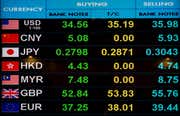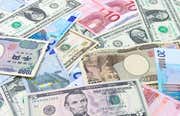According to the World Bank, the Japanese economy is the world's third-largest national economy. Japan is a significant exporter throughout the world. Because of Japan's large amount of trade with the United States, Asia, Europe and other countries, multinational corporations have a regular need to convert local currency into yen and vice versa. Consistently low interest rates has led to a storied history with the yen being a popular currency for the carry trade as well. For these reasons, the USD/JPY is heavily traded in international currency markets. Investors interested in currency trading should closely examine the Japanese economy and the USD/JPY to determine if this is a pair they want to follow.
The Japanese Economy
A small country with little in the way of natural resources, Japan has relied on a strong work ethic, innovative manufacturing techniques, a mastery of new technologies, a high national savings rate, and a close partnership between the government and business sectors to overcome its natural disadvantages. Although the country and its economy were severely damaged during the World War II, the Japanese economy has since grown to become larger than that of every country in the world except the United States.
However, following more than 40 years of nearly unprecedented economic growth, the early 1990s saw an end to the Japanese bull markets in domestic equities and real estate. The bursting of these bubbles led to a sharp economic slowdown and a deflationary spiral. The Japanese banking system was saddled with trillions of yen in bad loans and subsequently cut back its financing activities. Japanese consumer spending also slowed as the country entered a prolonged economic downturn. For nearly two decades, the Japanese government has struggled to reinvigorate the economy and return growth to its previously robust rates. Although these efforts, along with the aggressive use of monetary policy, have not yet been completely successful, Japan has become an economic powerhouse and an important source of global economic activity. (For background reading, see The Lost Decade: Lessons From Japan's Real Estate Crisis and Crashes: The Asian Crisis.)
The Japanese Yen
The Japanese yen is the most heavily traded currency in Asia and the third most actively traded currency in the world. In 2016, the Yen was on one side of approximately 21.6% of daily transactions. At one point during the 1980s, there was conjecture that the yen would join the U.S. dollar as one of the world's reserve currencies. Japan's extended economic decline has ended this supposition, at least temporarily, but the yen remains an extremely important currency in the global financial markets. (Find out how yen carry trades contributed to the credit crisis in The Credit Crisis And The Carry Trade.)
One consequence of Japan's extended period of slow economic growth is that the Japanese central bank has been forced to keep its interest rates very low to spur economic growth. These low interest rates have made the Japanese yen extremely popular in the carry trade. Historically, with carry trades, investors and speculators sell the yen and use the proceeds to purchase higher yielding currencies. This regular selling of the yen has kept its level lower than it otherwise might have been. In recent years, the Bank of Japan has aggressively used interest rates to spur economic growth and have even pushed their central bank rates of minus 0.10%.
Trading the U.S. Dollar/Japanese Yen
The USD/JPY features low bid-ask spreads and excellent liquidity. As such, it is an excellent starting place for newcomers to the currency market as well as a popular pair for more experienced traders. One of the attractions of currencies is that the market is open 24 hours a day, five-and-a-half days a week. U.S.-based investors who enjoy trading at night might consider focusing on the U.S. dollar/yen because the yen is heavily traded during Asian business hours. (For more insight, see In the forex market, how is the closing price of a currency pair determined?)
As previously discussed, selling the yen as part of the carry trade has often been a popular strategy. The popularity of the yen carry trade usually depends on the state of the global financial markets. Interest rates set by central banks around the globe have all moved near zero and in the case of Japan have moved into the negative. While the Yen has traditionally been the funding currency in the carry trade, given the negative rate, many traders have turned toward speculation and betting on short-term shifts in risk tolerance as their preferred trading strategy. Depending on future policy changes, only time will tell when and how traders will choose to return to the yen as the funding currency in the carry trade, which has been the amin driver of the trend over much of the past decade.
Another factor to be aware of when trading the yen is Japan's dependence upon imports and exports. Because Japan is largely dependent on imported oil and other natural resources, rising commodity prices can hurt the Japanese economy and cause the yen to weaken. Slower economic growth among its major trading partners can also cause Japan's export-dependent economy and the yen to weaken. Japan's export dependency can also prompt central bank intervention when the yen begins to strengthen. Although experts debate the effectiveness of central bank interventions, it is important to at least consider what impact they might have. The Bank of Japan has a reputation for intervening in the currency market when movements in the yen appear likely to threaten Japanese exports or economic growth. Investors should be aware of this so that they are not caught by surprise if intervention by the Bank of Japan causes a reversal in the trend of the yen. (For related reading, check out Using Currency Correlations To Your Advantage.)
As the most liquid currency in Asia, the Japanese yen can also be a proxy (substitute) for Asian economic growth. When economic or financial volatility strikes Asia, investors may react by buying or selling the Japanese yen as a proxy for that of other Asian nations whose currencies are more difficult to trade.
Finally, it is important for traders to remember that Japan has endured an extremely long period of subpar economic growth and correspondingly low interest rates. Traders should pay careful attention to the BOJ's use of monetary policy as a meas of driving economic growth. Commentary around rates and possible changes are all major drivers of yen-related pairs. (For related reading, see: The Fundamentals Of Abenomics)
Forex Currencies: The GBP/USD
-
 Investing
InvestingFXY: Should You Short the Yen?
Discover several reasons why investors may profit from short selling the Japanese yen against the U.S. dollar. -
 Trading
Trading6 Currencies With A Bright Future
Have a rewarding new year by investing in these currencies. -
 Investing
InvestingJumping for an Old Japan ETF
This Japan ETF is topping U.S. stocks this year, but it has some drawbacks. -
 Trading
Trading6 top-traded currencies and why they're so popular
Every currency has specific features that affect its underlying value and price movements in the forex market. Learn why these currencies are especially popular for trading. -
 Investing
InvestingJapan's Expansionist Policies Have Brought Unexpected Results
Twenty-five years of expansionary policy, both fiscal and monetary, has not yielded the desired results for the Japanese economy. -
 Trading
TradingTop 5 Hardest-Hit Currencies
The value of a country's currency is dependent on many factors that will cause it to fluctuate, relative to other world currencies. -
 Trading
TradingCurrency Carry Trades 101
The carry trade has generated positive average returns since the 1980s, but only in the past decade has it become popular among individual investors. -
 Trading
TradingCurrency fluctuations: How they effect the economy
Currency fluctuations are a natural outcome of the floating exchange rate system that is the norm for most major economies. Read on for what effects these changes can have. -
 Trading
TradingThe U.S. dollar and the Japanese yen: An interesting partnership
Learn more about the USD/JPY relationship, wherein the yen can be partially explained in terms of Treasury bonds.



